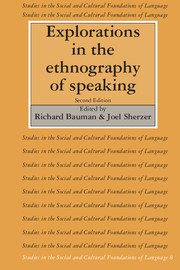Book contents
- Frontmatter
- Contents
- INTRODUCTION TO THE SECOND EDITION
- I PREFACE AND INTRODUCTION
- II COMMUNITIES AND RESOURCES FOR PERFORMANCE
- Introduction
- 1 A Quantitative Paradigm for the Study of Communicative Competence
- 2 Language Identity of the Colombian Vaupés Indians
- 3 ‘Our Ancestors Spoke in Pairs’: Rotinese Views of Language, Dialect, and Code
- III COMMUNITY GROUND RULES FOR PERFORMANCE
- IV SPEECH ACTS, EVENTS, AND SITUATIONS
- V THE SHAPING OF ARTISTIC STRUCTURES IN PERFORMANCE
- VI TOWARD AN ETHNOLOGY OF SPEAKING
- Notes
- References
- Index of names
2 - Language Identity of the Colombian Vaupés Indians
Published online by Cambridge University Press: 05 June 2012
- Frontmatter
- Contents
- INTRODUCTION TO THE SECOND EDITION
- I PREFACE AND INTRODUCTION
- II COMMUNITIES AND RESOURCES FOR PERFORMANCE
- Introduction
- 1 A Quantitative Paradigm for the Study of Communicative Competence
- 2 Language Identity of the Colombian Vaupés Indians
- 3 ‘Our Ancestors Spoke in Pairs’: Rotinese Views of Language, Dialect, and Code
- III COMMUNITY GROUND RULES FOR PERFORMANCE
- IV SPEECH ACTS, EVENTS, AND SITUATIONS
- V THE SHAPING OF ARTISTIC STRUCTURES IN PERFORMANCE
- VI TOWARD AN ETHNOLOGY OF SPEAKING
- Notes
- References
- Index of names
Summary
In the Vaupés territory of southeastern Colombia are over twenty exogamous patrilineal descent units, each of which is identified with a distinct language. In the literature on the Vaupés, these units have always been called ‘tribes.’ Although no single generally accepted definition of tribe exists, those most frequently offered in the literature are concerned with the presence of factors such as (1) tribal territory; (2) political, ceremonial, or warrior roles as tribesmen; (3) more intra-tribal as opposed to intertribal interaction; (4) some proportion of marriages occurring within the tribal unit; and (5) some cultural differences between neighboring tribes. None of the definitions utilizing these factors permits calling the Vaupés units tribes; at present these units mainly function as marriage classes, even though they are each identified with different languages. Hence, thinking of them as tribes is misleading and in this paper they are called ‘language-aggregates.’
This paper is concerned with the role language plays in the Vaupés as a symbol of membership in a language-aggregate, and with the relationship between language and Vaupés social structure. The first section gives a brief ethnographic introduction and description of Vaupés multilingualism. The second section analyzes Vaupés languages as emblems of the language-aggregates and as badges of identity for individual Indians. Finally, some ways in which the Vaupés data apply to some of the current issues on sociolinguistics and the ethnography of speaking are suggested.
- Type
- Chapter
- Information
- Explorations in the Ethnography of Speaking , pp. 50 - 64Publisher: Cambridge University PressPrint publication year: 1989
- 8
- Cited by



